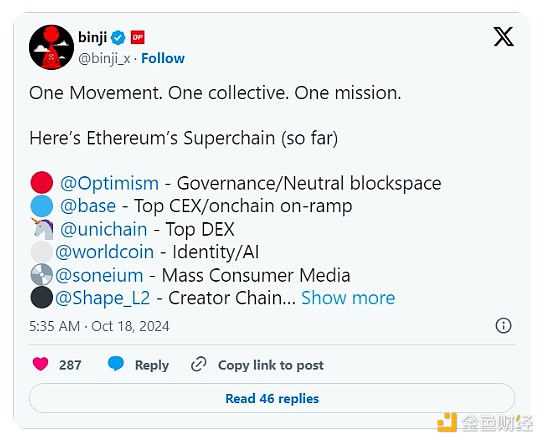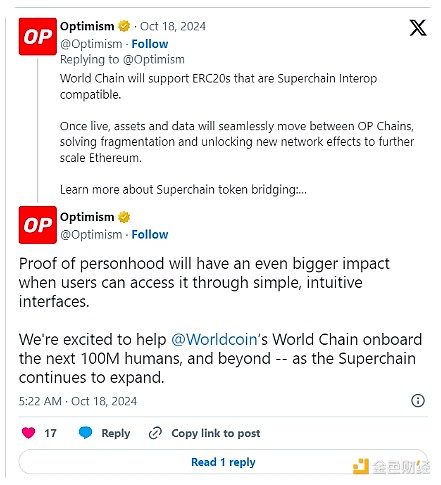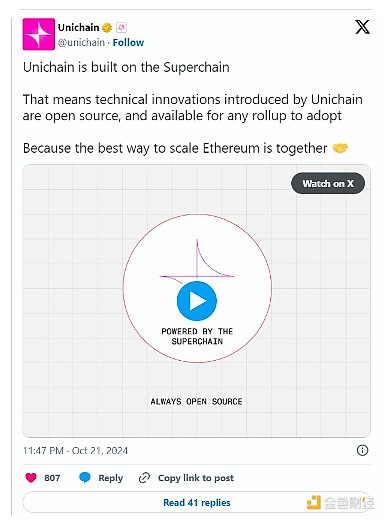Author: Jonah Roberts, Bankless author/researcher; Translation: Jinse Finance xiaozou
Ethereum L2 has always been a chaotic battlefield. For many years, the top L2s have been competing fiercely to attract developers to develop and create their applications in their respective interconnected ecosystems.
When the dust settles, the top development teams continue to choose Optimism Superchain.
This article will analyze what are the main projects developed and built on the OP Stack and why Superchain can win the favor of developers.
1. Optimisim Superchain Market Positioning
In the highly competitive block space market, many blockchains provide similar services. Ensuring market share requires not only good technology, but also innovative use cases and strategic growth. Optimism has done a good job in this regard. It has adopted a top business development model to turn Superchain from a bold name into a truly dominant reality.

While the total locked value (TVL) on the OP mainnet still lags behind competitors such as Arbitrum and Polygon, the Superchain is still performing well, thanks in large part to Base, whose TVL recently surpassed Arbitrum, according to DefiLlama.
While Arbitrum and other L2s have attempted to expand the interconnected blockchain ecosystem, their success has been relatively limited relative to Optimism.
This is because the Superchain has an incredible network effect, and it seems to have truly won the meme war and become the golden place for on-chain development.
This does not completely diminish the importance of other L2s, which will continue to play an important role in Ethereum scaling, but it is important to note that OP Stack has clearly become the de facto development site for the industry's largest players.
2. Superchain projects to watch
Optimism's modular design enables some of the industry's largest players to create influential products under the umbrella of Superchain. A recent example is World Chain, a Superchain launched by OpenAI CEO Sam Altman's Web3 concept World (formerly WorldCoin).
Sponsored Business Content
World Chain is designed to be a verifiable real-person network. It may be the most advanced identity system for Web3 to date. World Chain already has 7 million unique address users, enough to verify this. As of August, there are more unique address wallets holding $20 WLD tokens than the total number of unique address wallets holding $20 USDC across all Ethereum networks.

Another heavyweight that recently joined the Superchain is Uniswap, which launched Unichain, a dedicated rollup designed to be the liquidity center of the Superchain. As the largest DEX in the cryptocurrency space, Uniswap processes trillions of dollars in trading volume for millions of users. By integrating liquidity within the Superchain, Unichain aims to eliminate the inefficiencies caused by the dispersed liquidity between different chains, indicating that the Uniswap Foundation believes that the Superchain will be the gathering place for most user activities.

There is also Coinbase’s most ambitious on-chain project, Base. Known for lightning-fast transactions and fees of less than 1 cent, Base has quickly become the first choice for dApps and developers. The exponential growth of Base has greatly boosted the adoption of this Superchain, demonstrating the power of network effects. The exponential growth of the network is one of the most important crypto narratives this year and is expected to continue to play a core role in the future.
Finally, Kraken, just this week, Kraken announced the launch of their own brand new L2, called Ink. Ink seems to be a direct competitor to Base, but in the long run, both are beneficial to the development of the entire Superchain ecosystem.
3. Optimism's Vision and Philosophy
Optimism's mission is described as "forking capitalism", aiming to achieve a financial vision that emphasizes better value alignment and accounting responsibility. This philosophy is reflected in the design and governance of the network, which is led by the Optimism community. The network's inclusive architecture and open source principles support a decentralized economy where participants jointly make rules. This vision challenges the traditional centralized profit-driven model by providing a model that prioritizes community ownership and inclusiveness.
In addition, the design goal of the Superchain's economic model is to create shared incentives between all chains on the OP Stack. Optimsim and its OP tokens directly benefit from a revenue-sharing model in which part of the fees generated by activities on a single chain such as Base or Ink will flow back to the main network. This optional framework ensures that the growth of some Superchain rollups contributes to the entire ecosystem, turning potential competition into cooperation.
This revenue-sharing model not only expands Ethereum's technology, but also complies with the principles of decentralization and sustainable growth of the network. By enabling each chain to contribute to the economic vitality of the ecosystem, Optimism is positioned to grow with the evolving network.
4. Future Prospects
It is undeniable that the Optimism Superchain is the current leader in L2 expansion, but we are still in the early stages of rollups. Major non-Web3 players are still in the early stages of exploring on-chain possibilities, leaving room for other players to seize market share and challenge the narrative in the coming years.
As the network effect of this Superchain continues to expand, it will become increasingly difficult for other players to attract new activities elsewhere - especially when the next wave of users gain a unified Superchai user experience. Optimism's current growth lays the foundation for long-term dominance in the Ethereum ecosystem.
 Kikyo
Kikyo













